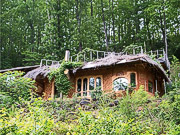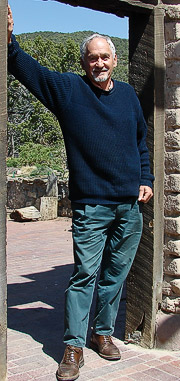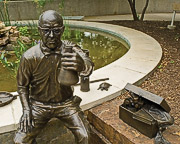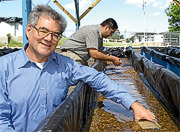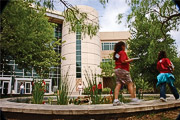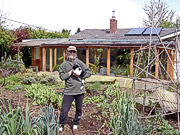 |
|||||||||||||||||

Being Green
|
By any standard, Rod Rylander ('61) has very little.
He lives in an adobe cottage of his own design nestled in a North Carolina mountainside. The few appliances and electronic devices — a refrigerator, a computer and a few LED lights — inside the 400-square-foot hut's cordwood-framed walls are powered by solar panels. He showers with sun-heated water and cooks his meals in a wood-fired stove. What Rylander doesn't have is an electric bill or a mortgage. And it's been four years since he stopped driving a car (the last one he owned was a fuel-efficient Honda) and committed to traveling only where a train, a bus or his own feet could take him.
While most consumers fret over the rising costs of gas and electricity, Rylander subsists comfortably on $700 a month. His choice to live off the grid is a bold step — even for one of a growing number of Americans concerned about the sustainability of their modern lifestyle. Rylander, though, insists that, compared with living conditions he's encountered in other countries, his ascetic dwelling isn't so radical. "I feel like much less of a hypocrite and much happier having a footprint on the earth that is around the average of the world's population," Rylander says. A green mindset An environmentalist who walks the walk, Rylander devotes much of his time to designing and building sustainable housing. He credits his time at UNT, under the tutelage of the venerable J.K.G. "Doc" Silvey, with turning his fanciful interest in the natural world into a keen awareness of humanity's role in managing or destroying the earth's finite resources. His experience is just one example of the deep roots of environmental awareness at UNT, where green represents more than just a school color. UNT's faculty, students and administrators have joined forces to renew the university's dedication to all things green and further build on its environmental legacy.
The goal is to create an even more sustainable campus and launch new initiatives aimed at achieving it. And with a leading curriculum in environmental studies and philosophy, a campus commitment to recycling and energy efficiency, and a multitude of student-driven sustainability efforts and environmentally minded alumni, UNT is poised to take on the most serious environmental issues of the 21st century. Already, the university has committed to becoming a climate neutral campus. Housing and facilities officials have taken comprehensive measures to reduce water and energy consumption. Researchers have taken a leading role in preserving vanishing ecosystems and addressing air and water quality problems at home and abroad. Students and alumni, meanwhile, are using environmental lessons learned at UNT in their personal and professional lives. "UNT is like a small city, and the small changes we make can make a big difference," says Samuel Atkinson, professor of environmental science in the Department of Biological Sciences and the Institute of Applied Sciences.
Environmental research Like Rylander, Ken Dickson ('66, '68 M.S.), Regents Professor of biological sciences, considers himself a Silvey disciple. Long before the Sierra Club and Earth Day existed and the term "sustainability" had been coined, Silvey, a longtime biology chair, was conducting pioneering research on water quality. "Environmentalism didn't just come on the scene," Dickson says. "It has a long legacy at North Texas." While working on his bachelor's and master's degrees in biology, Dickson assisted in Silvey's research. After earning a doctoral degree from Virginia Tech, Dickson returned to UNT in the late 1970s and was asked to direct the Institute of Applied Sciences, an interdisciplinary research consortium founded by Silvey.
Under Dickson's guidance, the institute became widely recognized as a leader in environmental research. Its scientists, who are faculty members in the biology, computer science, geography, math and philosophy departments, have conducted studies for federal, state and local agencies and industry representatives. "What it really takes to deal with the environment is a team of people," Dickson says. "You can't solve it by science alone. That's what we've tried to build here. The collaboration is not limited to this campus. It's happening all over the world." Over the years, the scope of the institute's research has expanded. As in Silvey's time, a heavy emphasis continues to be placed on water studies through the Aquatic Toxicology Laboratory and the Water Research Field Station. But IAS also oversees the Center for Environmental Archaeology, the Center for Remote Sensing and Land-Use Analyses, the Environmental Chemistry Laboratory, the Environmental Modeling Laboratory and the Reservoir Limnology Laboratory. In the classroom In addition to research, the institute needed to have a strong classroom presence, Dickson believed. So he pushed for the founding in the early 1990s of the master of science and doctor of philosophy degree programs in environmental science, which the institute's faculty members coordinate. Since the early 1990s, UNT also has boasted the nation's most comprehensive graduate program in environmental philosophy, also recognized as the best in the world by the International Association for Environmental Philosophy. The Department of Philosophy and Religion Studies offers master's and doctoral degrees in environmental ethics. And each of the department's faculty members has an expertise in environmental issues. For example, Ricardo Rozzi, assistant professor of philosophy, leads UNT's efforts with the Chilean government to preserve a critical biosphere at the southern tip of South America. And Gene Hargrove, professor of philosophy, is the founder and editor of Environmental Ethics, the first peer-reviewed journal in the environmental philosophy field.
The opening in 1998 of the Environmental Education, Science and Technology Building has made possible a greater level of interactivity among environmental thinkers from a variety of disciplines. And that's exactly what the facility was designed to do. The EESAT predates the U.S. Green Building Council's Leadership in Energy and Environmental Design rating system, which offers specific guidelines for designing a green building. But many of the structure's attributes — soy-based flooring, an energy-efficient cooling system and sunlight-absorbing windows, to name a few — are in line with LEED-certified buildings. The EESAT also features third-floor faculty offices that are not cordoned off by department. Instead, scientists share a physical space with philosophers and community service experts. "It's a very interdisciplinary building," Dickson says. "It's made to bring people together." Applying knowledge UNT's emphasis on environmental issues has produced a broad base of alumni who carry green thinking into their professional lives. For example, Kenneth Banks ('94, '96 M.S., '99 Ph.D.), who earned his graduate degrees in environmental science, is using lessons he learned in a laboratory to ensure that tap water in people's homes is safe to drink. Banks has served for the past seven years as the manager of Denton's Division of Environmental Quality, overseeing the city's water pretreatment division, water/wastewater laboratory, watershed division, stormwater division and utility projects. "I am involved in practically all environmental issues in the city," Banks says. He isn't exaggerating. His division deals with everything from air quality concerns and mosquito control to watershed monitoring and building code/energy efficiency initiatives. Other than having to spend more time than he'd like at his desk and less time doing research and outreach initiatives, Banks says he can't complain too much about being in charge of maintaining and improving the beauty and well being of his community. "It makes me very proud to see all the things that Denton does concerning environmental issues, especially considering that our city does not have many of the resources of the 'big cities,'" he says.
Living green Other alumni are focused on living a green lifestyle. Jan Spencer ('74), who went by the name Howard when he earned his geography degree, has turned a 1950s tract home on a quarter-acre lot in Eugene, Ore., into what he describes as a permaculture Shangri-la. Spencer — whose appreciation for the environment dates back to his first visit to campus on Earth Day in 1970 when he was a high school senior — removed from his property two iconic elements of the typical American suburban residence: his grass lawn and driveway. In their place, he planted brambles, vines, fruit trees and a vegetable garden. The vegetables, watered with a rainwater catchment system, provide much of the food he eats. He has a solar hot water system and uses passive solar architectural design to help heat the house and a detached bungalow. Spencer, a mural artist, did the landscaping and much of the remodeling himself.
"What I have right now makes perfect sense," Spencer says. "I wouldn't have foreseen the details. That's part of the fun. … I didn't know I'd plant an English walnut tree where my driveway used to be." Spencer's project has become a community educational resource for visiting school groups and curious observers. He has made presentations about his property and his social and political perspectives at conferences on sustainability, and he actively participates in a permaculture guild with others who share his belief in the need for the United States to reduce its cultural and economic dependence on fossil fuels. "As a species we're wrecking the planet," Spencer says. "We need to find a new way to take care of our needs." Robert Bolman, a green homebuilder in Eugene, says he considers Spencer's property a shining example of how to turn a typical suburban home into an energy-efficient, sustainable living space. "Jan is creating this model that others can look to," Bolman says. "In five or 10 years, you'll see Americans wake up to the usefulness of what Jan's doing." Creating a sustainable campus UNT is not just cultivating green thinking. Since arriving at UNT, President Gretchen M. Bataille has focused on creating a more sustainable campus. Last spring, UNT became the first university in the nation to partner with the Chiapas Project in its Recycle to Eradicate Poverty program. The initiative keeps old cell phones and the toxic chemicals they contain out of landfills and in turn raises funds to support the micro-financing of small businesses operated by women in impoverished areas in Chiapas, Mexico, and elsewhere.
Recently, Bataille signed the American College and University Presidents Climate Commitment, a nationwide initiative of college and university presidents and chancellors dedicated to counteracting climate change by taking steps to make their campuses climate neutral. The agreement commits the university to taking an emissions inventory, setting a target date and interim milestones for becoming climate neutral, taking immediate steps to reduce greenhouse gas emissions, integrating sustainability into the curriculum and making it part of the educational experience, and making the action plan, inventory and progress reports publicly available. The university already is well on its way to accomplishing many facets of the commitment. UNT has adopted the U.S. Green Building Council's LEED Silver standard for all new facilities. And Bataille has established a sustainability council, headed by Atkinson, to determine what green initiatives already take place on campus and what opportunities UNT has to further its efforts to promote sustainable development. A number of green and energy-efficient programs implemented in recent years are conserving water and energy and saving UNT money. The recycling program collects paper, aluminum, plastic, cardboard, styrofoam, printer cartridges and fluorescent tubes. In one six-month period, the university collected 133 tons of paper and 56 tons of cardboard. The housing department recently installed low-flow, air-injected shower heads and faucets in most residence hall rooms. And front-load washing machines have replaced the water-gobbling top-load variety. Those and other water-saving features in the residence halls are annually saving UNT 8.2 million gallons of water and $56,000. The university saves more water costs by using mostly native plants that require little water in its landscaping features. Not to mention, UNT has saved more than $1.2 million a year on energy costs during the last 10 years by signing an energy savings performance contract. The contractor has replaced inefficient lighting and installed a digital control system on most mechanical equipment. Variable frequency drives placed on pump and fan motors allow that equipment to run at a lower-than-maximum energy output. "Saving energy is the smart thing to do, because we're saving money and it's right for the environment," Atkinson says. Greener pastures ahead Rylander — who resides in his so-called Hobbit House in North Carolina's Earthaven Ecovillage when he isn't traveling to Costa Rica and elsewhere to promote sustainable housing — maintains that he is not trying to convert the masses to his way of life. He does, however, encourage people to ask: "Is what I am doing right now going to jeopardize my future, and if so, how can I have a sustainable future for my children?" Dickson, for one, sees a bright future ahead if the UNT community and other like-minded individuals continue thinking green. "People are realizing the environment is worth taking care of," Dickson says. "I'm an optimist. There are big challenges, but I think we're capable of dealing with them."
|
|||||||||||||||||||||||||||||||||||||||||||||||||||||||||||||||||||||||||||||||||||
